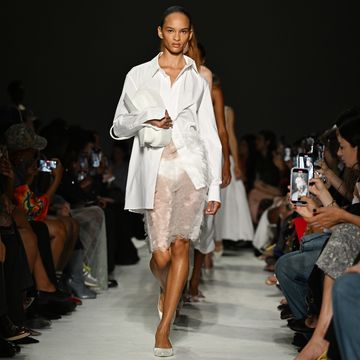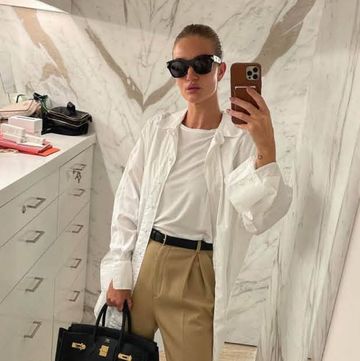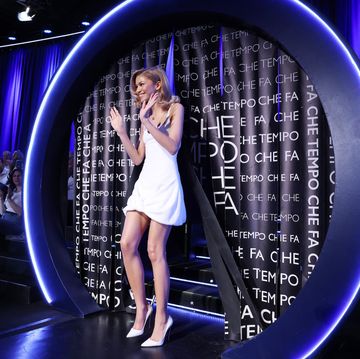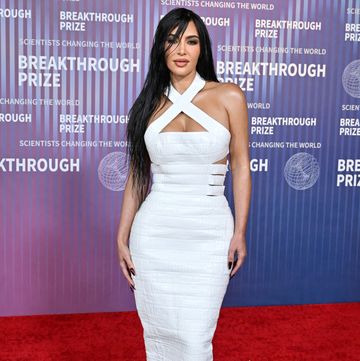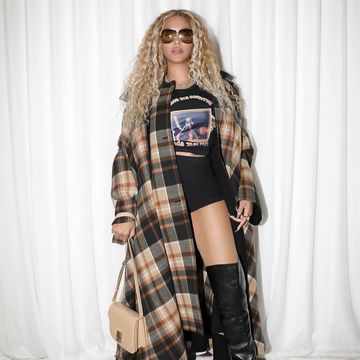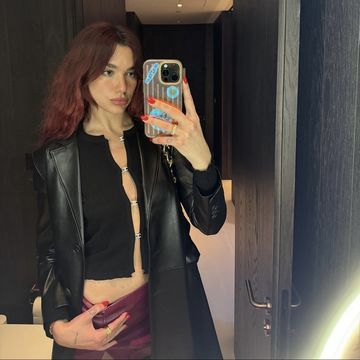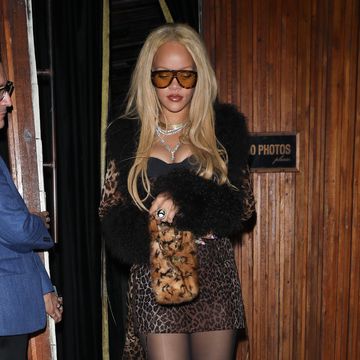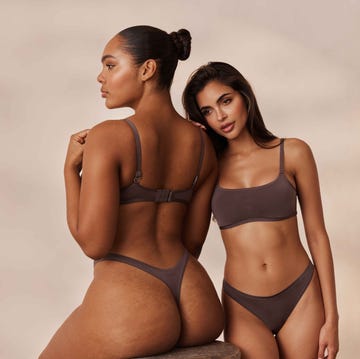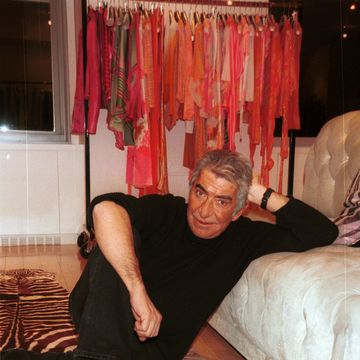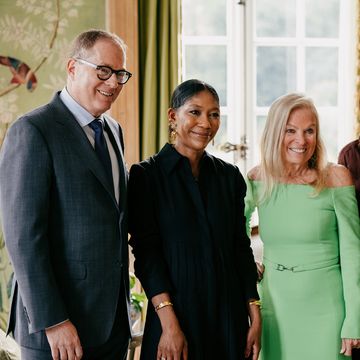From ELLE October 2011:
Frida Giannini sits at the helm of a luxury power house. But what has shaped her unstoppable creative force?
Getty Images
I first met Frida Giannini on the banks of the river Arno in Florence, Italy, ankle-deep in mud. Well, I was ankle-deep in mud. She was in a much more precarious position – astride a black stallion that reared, snorted and threatened to take off with her and tip her into the river. I remember her panic, not because she thought she would be thrown to her death in a tragic riding accident for the sake of an ELLE magazine shoot, but because she didn’t want to miss an important meeting that afternoon.
She was a brunette then, with a pale, serious face. Her hair was parted in the middle and scraped into a no-nonsense ponytail. ‘Giannini is hardly what you’d expect of a Gucci doyenne,’ I wrote at the time. ‘She prefers flat boots to wicked stilettos – no high-maintenance hairdo or heavily made-up face here. You’d at least expect her to have Gucci nails, manicured to perfection, but as she says, “There’s no time for al that right now.”’
It was 2004 and Frida had just been appointed creative director of Gucci’s accessories division – her ‘dream job’, as she put it back then – alongside Alessandra Facchinetti on womenswear and John Ray on men’s. The ‘Gucci Trio’ had been put in charge following the dramatic departure of their boss, the headling-grabbing, sex-supplying, design-king-cum-marketing-guru Tom Ford. Ford, along with his CEO Domenico de Sole, had transformed Gucci – and you could even say the fashion industry – by first demonstrating how to turn an ailing fashion house into a profitable luxury brand and then building a fashion conglomerate, the Gucci Group, that hovered up every wantable label of the moment, including Yves Saint Laurent, Balenciaga, Stella McCartney and Alexander McQueen.
So who were these unknown pretenders to the Gucci throne? The thinking at the time was that PPR – the conglomerate that had bought out the Gucci Group – reluctant to hire a ‘star’ designer in the Ford mould, had gone for three safe pairs of hands to keep things ticking over. But the next two years would be turbulent for Gucci. Poor Alessandra Facchinetti’s womenswear received such a critical drubbing that she resigned two weeks after her second show. ‘Alessandra is more shy, less aggressive than me,’ Frida had told me when I’d previously asked if the three creative directors were bonding. ‘Our relationship must be very good,’ she said, ‘because at the end of the day, we have a lot of dinner parties together.’ Frida, of course, was the only survivor, emerging in 2005 as head of the entire brand.
Five years on, aged 39, Frida steers every creative facet of Gucci’s empire that maintains 327 stores and employs 8,000 people. Since she took over, profits have soared by an estimated 25 per cent to around £667m. Hence, she commands a salary that allows her to buy houses and Modiglianis: she has three of both. It is thanks to her consistency of vision – the slick, moneyed, professional luxury-reveller imbued with a much more potent femininity than Ford’s idealised brand of super-glossed womankind – that Gucci has become such an unstoppable luxury juggernaut. The brand’s global reach and financial status alone make Frida one of the most powerful women in fashion.
Looking at her now, I wonder if the fashion business has ever seen such a transformation? She is lying on a glass-topped table in her impressive Rome office, all vaulted frescoed ceilings, posing effortlessly for our photographer and oozing, well, Gucci-ness. Her poker-straight blonde hair falling into those mascara-thick lashes, tan glowing, manicured fingers twinkling in the glow of a knuckle-sized diamond (an engagement ring, I’m guessing, but from whom she remains firmly schtum). She looks like a shiny celebrity. But clearly, it’s not just the surface that’s changed – there’s more to this woman than a mere makeover.
‘To give you an idea,’ says Frida, removing her big black shades later at lunch, ‘when we first met in Florence, that was one of my first-ever photo shoots and now I do a photo shoot every week.’ We are sitting under a parasol outside her favourite restaurant in Rome, Pierluigi in Piazza dé Ricci, with her long-serving right-hand woman Patricia Buonanno and relative newcomer of fiver years, WW Brand Partnerships (special projects director) Jenny Galimberti. As Frida orders pasta – yes, pasta – the customers on the neighbouring table turn to stare. Perhaps they, too, are wondering if this preternaturally svelte woman is really going to allow a carbohydrate to pass her lips. Or perhaps they simply recognise her. ‘I could not be here with just a salad, I would be so sad,’ she laughs. The big, black shades go back on.
I want her to talk about her transformation from shy brunette bag designer to international blonde fashion superstar. She tells me that on her first trip to Los Angeles, at a dinner surrounded by celebrities, seated with Adrian Brody and Stevie Wonder, she couldn’t bring herself to say a single word. And that the prospect of a lunchtime interview with a prominent journalist would fill her with such dread that she wouldn’t be able to eat or sleep the day before. ‘Everything was so giant for me,’ she says. So what changed? How did she become Frida Giannini, the woman I saw leap up on stage six months ago at Gucci’s 90th-anniversary party, on the night of her a/w 2011 show, mic in one hand, punching the art with the other, to introduce ‘the brilliant, the talented, Miss COCO SUMNERRR!’ to the hard-to-please international fashion crowd?
‘There was a moment when everything clicked,’ she admits. February 6, 2008, to be precise. In a 42,000 sq ft tent on the northern law of the United Nations New York HQ, in front of Hollywood’s finest, Frida and Madonna co-hosted a Unicef event that raised more than £3 million for children in sub-Saharan Africa exposed to HIV/Aids.
‘It was the moment I realised that I could have fun – that is the key word, fun,’ she stresses. This magic ingredient that she’d been missing, did it come from chatting to Tom and Katie, or her ‘very good friends’ Mary J Blige and James Franco? No, it was the battle with Madonna over the décor for the event that had fuelled her confidence and nailed her shyness to the wall.
‘I had to organise everything with Madonna at her house in London. We met to discuss dishes, forks, candles, flowers. But then she had this idea to bring over statues from Malawi,’ says Frida.
‘And Frida had other ideas,’ interjects Galimberti.
‘I didn’t want to be so literal,’ declares Frida.
Which, according to Galimberti, led Frida to say something to Madonna along the lines of, ‘Just because I am from Rome does not mean I want to build the Colosseum in every location that I go to.’
The statues stayed in Malawi.
Last January, Frida invited me to Rome to sit on an initial design meeting for the a/w 2011 accessories collection. Two years ago, she persuaded the Gucci powers to move the design studio from Florence to her hometown of Rome, to a 16th-century palazzo, across the Tiber from the Castel Sant’Angelo (‘Florence is a jewel, but it’s too small,’ she explains. ‘I have guys in my team as young as 23 – they need a bigger city, a place where they can play after work’).
Seated around a large table where eight members of the design team – or ‘collaborators’ as they like to be known – who, fairly suspicious of me, ‘an external’, kept their distance. I was quite surprised to find that all five men on the design team wore, without exception, beards, which, together with their smart tailored jackets, gave them the look of fashion buyers from a glossy department store. The meeting also had more of a business feel to it than the creative brainstorm that I was expecting.
When Frida walked in, on time (‘I may be Roman but I’m always on schedule’), wearing a green chiffon dress and shiny black thigh-high boots, the chatter fell away and they instantly got down to work. ‘Bayzically, the team is presenting their ideaz and she is saying “yayss” or “no”,’ explained the most vocal collaborator, Alessandro Michele, head of accessories, who has worked at Gucci for 11 years.
Frida listened first to what each person had to say before giving her pronouncement. She measured a black leather clutch with a tape measure and asked a young woman to model it so she could see where it would sit on the body. She took a cow-sized ‘swatch’ of bright orange leather and scratched it with a nail, then rubbed out the mark with her thumb, then sniffed it and massaged it, as if to demonstrate the essential quality of the hide that had come straight from one of the Gucci tanneries and would be made into bags.
Occasionally, the entire group would break out with a ‘que bellisimo’ over a pair of black suede sandals with a towering 20cm heel, or erupt with laughter when Frida held a fluffy mink clutch bag in the crook of her arm as if it were a Chihuahua and barked ‘Woof! Woof!’
The mood boards leaning up on the large and otherwise featureless white-walled room revealed that team Gucci were going to, as Frida put it, ‘push this engine of colour’. Their heroine and visual references had already been chosen for the collection: alongside film stills of Angelica Huston ran the words ‘1970s silhouettes’, ‘timeless deluxe’, ‘superflare trousers’, ‘sleek tailoring’ and ‘classy’.
In Milan three months later, the day before the show, Frida let me sit in on the hair and make-up run-throughs, the model fittings and a last-minute casting for the show. One lucky ‘new face’ was about to find herself modelling on the career launch pad that is the Gucci runway. There were nerves and even tears as a very young blonde, Emily, slipped over in the 20cm-high boots. Frida’s response: ‘You have blisters? Can we find her some plasters please!...OK, take your time. Try again…Great, great.’
Along one side of the room, a row of staff on computers took note of any miniscule change to an outfit – such as a feather in the hair instead of a hat and how many buttons on a blouse should be undone – five, in this case. ‘It’s like fitting a jigsaw puzzle,’ explained Frida. We turned to watch Pat McGrath, the inspirational make-up artist, bat off Luigi Murenu, the hair stylist.
Pat: ‘Wow…wow…wow!’
Luigi: ‘Major hats!’
Pat: ‘Maybe a low ponytail?’
Luigi: ‘Sleek, chic, sharp!’
Pat: ‘A beautiful mouth then…with the hat.’
The Gucci entourage soon decamped to the show venue – a former old cinema on Piazza Oberdan and now Gucci’s custom-built 600-seater catwalk theatre. Michel Gaulbert, the fashion world’s music maestro, was putting the finishing touches to the music. ‘Low-energy music is a real mistake. You need to really feel it,’ called out Frida above Florence + the Machine. So that the music could be timed correctly according to daywear, eveningwear and the finale sections, four models walked in rotation on the stage, including poor Emily with the blisters, who must have been in some considerable agony by then. But it was another girl who took a tumble in her heels this time and Frida caught the casting director’s eye. ‘No way, no way,’ she mouthed.
The following day I was permitted backstage before the show, so I took the opportunity to ask as many people as possible about Frida, in the hope that in the chaos and with the heightened stress lvels, somebody might let something interesting slip – a weakness, or flaw, perhaps. However, Frida inspires a disciple-like following. Michele wanted to tell me about her decisiveness, insisting, ‘Frida has no doubts.’ Davide Renne, who works on womenswear, said, ‘It’s not really normal work. We all eat together, go out together, we’re best friends.’ Then Murenu, busily frizzing Natasha Poly’s ponytail, told me: ‘I don’t know what she takes, but she has full self control.’ And Poly, who has fronted the Gucci campaigns since Frida took the helm, pipped up, ‘I feel like I have a relationship with her. I always know what she wants.’
Back in Rome, after ELLE’s photo shoot, I asked Frida’s mother, Sandra Vellani (pictured opposite), what character traits her daughter has that have helped her to succeed. She talked about her generosity, her strong sense of duty and respect for her team. ‘As a family, we are all very strong characters. After 10 minutes of fury, we get everything out, release the tension, then everything is fine again,’ she said, in a deep, gravelly voice almost identical to her daughter’s. Frida is the only child of Sandra, a former headmistress and art-history teacher, and Antonio, an architect, and as a result, demonstrates a formidable air of self-sufficiency and single-mindedness. She confesses to need a ‘freak control over everything, or else I go crazy.’ It was her parents Frida called first when she was given Gucci’s top job. ‘We get a call from Frida who is crying and crying and she tells us that she has just been appointed creative director, so of course I said, “Why are you crying?”’ says Sandra. ‘And she was so emotional and excited about the whole thing that she said, “Do you think I’ll make it?” and I said, “but of course you will.”’
Sandra and Frida look like mother and daughter, both physically slight, although I suspect Frida would never jangle with quite so much gold and diamonds. ‘My mother is very neo-classic, baroque, gold. My father is so sharp and modern. They are refurbishing their house at the moment, I have no idea what it will look like. Every day they call me and try to convince me to push their ideas on to the other one. I tried to help them create a balance, but believe me, after a while I was exhausted.’ She says it was intense being the only hild, ‘That was the reason I wanted to leave the house because I couldn’t rest there. I needed to be a rebel.’ So instead of studying something academic, as was hoped, she headed to Rome’s fashion academy.
There’s something different about Frida today. She looks less ‘Gucci doyenne’ – sweeter, in a loose black top (unusual for her), black leather trousers and black ballet pumps with bows on them (also out of character). It turns out she is in love, she says. ‘But I cannot say who it is, not yet.’
So you are happy? I ask her. ‘Yes, and I think that is reflected in my job. If I had to look back on my work in the past three years I think I had an evolution because I evolved as a woman. When you suffer you grow up, you know what you want and are more confident.’
I’m amazed to hear Frida talk like this; she’s not exactly known for unzipping her self-control. ‘I fell in love again – and much more than before, probably,’ she muses. She remains close to her former husband, with whom she was married for three years. ‘We realized that we were not so much in love, it was more of a dream to be together. I never thought to have a child with him and after a while you understand that you can’t just be good friends and live together, you need to share a project for your life. It was hard, I suffered a lot, it was a failure for me.’
And failure is not something Frida Giannini is used to, after all. But for no, at least, life is blissful. ‘Sure. Inner happiness, good energy – I think when you feel so positive everything is easier to manage. You look at your life in a different light.’

